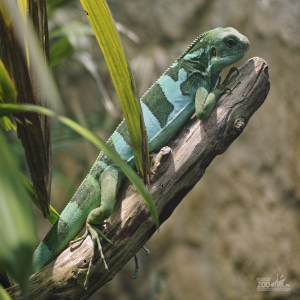 The Fijian banded iguana is found on the southeastern Fijian islands. In the wild they live between 10 to 15 years while in capivity they can live over 25 years. Fijian banded iguana can reach 60 cm (24 in) in length when measured from snout to tail tip and can weigh up to 200 grams (7 oz). They have a short (0.5 cm) crest. The Fijian banded iguana are sexually dimorphic, the males which are slightly larger, have two or three white or pale-blue bands 2 cm (.79 in) wide crossing their emeraldgreen background with a pattern of spots and stripes on the nuchal region and their tails also may have the bands. The females may have some light spots or partial bands. Their underside and nostrils are colored yellow with red-orange eyes. They are one of the few species of iguana found outside of the New World and one of the most geographically isolated members of the Iguanidae family. It is thought that this iguana was introduced by humans to the Tonga area. Predators of the Fijian banded iguana include rats, mongooses, and cats. The biggest threat to them is the loss of habitat due to fires, storms, agricultural development and competition from feral goats Humans take them for food and for the illegal pet trade.
The Fijian banded iguana is found on the southeastern Fijian islands. In the wild they live between 10 to 15 years while in capivity they can live over 25 years. Fijian banded iguana can reach 60 cm (24 in) in length when measured from snout to tail tip and can weigh up to 200 grams (7 oz). They have a short (0.5 cm) crest. The Fijian banded iguana are sexually dimorphic, the males which are slightly larger, have two or three white or pale-blue bands 2 cm (.79 in) wide crossing their emeraldgreen background with a pattern of spots and stripes on the nuchal region and their tails also may have the bands. The females may have some light spots or partial bands. Their underside and nostrils are colored yellow with red-orange eyes. They are one of the few species of iguana found outside of the New World and one of the most geographically isolated members of the Iguanidae family. It is thought that this iguana was introduced by humans to the Tonga area. Predators of the Fijian banded iguana include rats, mongooses, and cats. The biggest threat to them is the loss of habitat due to fires, storms, agricultural development and competition from feral goats Humans take them for food and for the illegal pet trade.
Location: The Lower RainForest
Share:
Range
The Fijian banded iguana is found on the Fijian islands of Aiwa, Avea, Balavu, Beqa, Dravuni, Fulaga, Kabara, Lakeba, Moturiki, Nggamae, Oneata, Ono, Taveuni, Totoya, Vanua Levu, Vatu vara, Vatulele and Wakaya.
Habitat
They are found in the high cloud forests and low coastal swamps. All of their time is spent in trees.
Conservation Status
Endangered
Primary Threats
Residential and commercial development, invasive species and diseases
Gestation
The Fijian banded iguana has the longest incubation period of all the iguana species, 160 to 170 days.
Litter
The female will lay between 3 to 6 eggs at a mating.
Behavior
Most of the iguana’s day is spent in the trees basking in the sunlight. The Fijian banded iguana is diurnal, spending part of each day foraging, basking, and watching over their territory. When the highly visual male comes across another male, he will aggressively defend his territory by bobbing its head in a warning. The more excited he is, the faster his head
moves. He will deepen his green coloration to intensify his bands. He will attack with an open mouth and possibly expand the dewlap to appear larger.
Reproduction
The breeding season is usually in November but has been known to also occur in April or May. The iguana usually only breed once a year. The male attracts the female by rapidly bobbing its head and then using its tongue to flick the female’s back and forelimbs. After mating, the female digs a diagonal nest in the ground which may reach a depth of 25 cm (10 in) and deposits between 3 to 6 eggs. The nest will then be covered with soil and leaf litter. The female will guard the nest. A week before hatching the young iguana shell will get a brown oval mark on its surface. This is where the young iguana will emerge after taking up to a day to come out of the egg. The young iguana will then dig themselves out of the soil. Immediately, the young iguana is responsible for finding its own food and a place to hide. They get moisture by licking the wet leaves since their births occur during the rainy season.
Wild Diet
The Fijian banded iguanas are herbivorous. They feed on leaves, fruit, and flowers of trees and shrubs. They particularly like the hibiscus flower of the Vau tree and fruit such as bananas and papaya.
Zoo Diet

